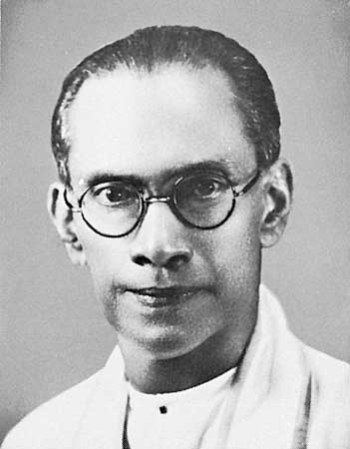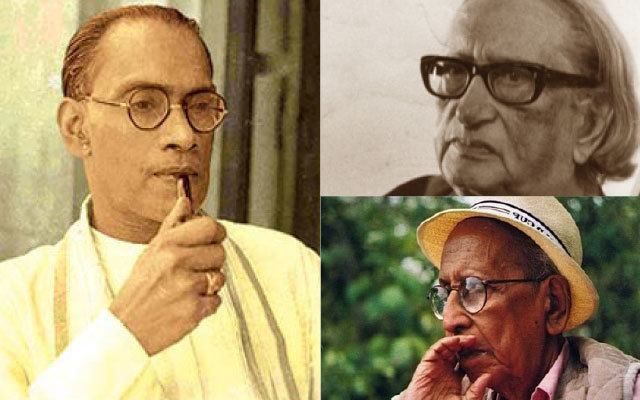Preceded by N. M. Perera | Name S. R. | |
 | ||
Spouse Sirimavo Bandaranaike (m. 1940) Books Devolution in Sri Lanka: S.W.R.D. Bandaranaike and the Debate on Power Sharing, Aturudan vu apeksakaya Children Chandrika Kumaratunga, Anura Bandaranaike, Sunethra Bandaranaike Similar People | ||
S w r d bandaranaike
Solomon West Ridgeway Dias Bandaranaike (Sinhalese: සොලමන් වෙස්ට් රිජ්වේ ඩයස් බණ්ඩාරනායක,Tamil: சாலமன் வெஸ்ட் ரிட்ஜ்வே டயஸ் பண்டாரநாயக்கா; 8 January 1899 – 26 September 1959), frequently referred to as S.W.R.D. Bandaranaike, was the fourth Prime Minister of Ceylon (later Sri Lanka) and founder of the left wing and Sinhala nationalist Sri Lanka Freedom Party, serving as Prime Minister from 1956 until his assassination by a Buddhist monk in 1959.
Contents
- S w r d bandaranaike
- What is S W R D Bandaranaike Explain S W R D Bandaranaike Define S W R D Bandaranaike
- Early life and education
- Early political career
- Opposition
- Prime Minister
- Assassination
- Family life
- Legacy
- References

What is S. W. R. D. Bandaranaike?, Explain S. W. R. D. Bandaranaike, Define S. W. R. D. Bandaranaike
Early life and education

Bandaranaike was born in Colombo, Ceylon, to an elite Sinhalese Anglican Christian family and was the son of the powerful Sir Solomon Dias Bandaranaike the Maha Mudaliyar (the chief native interpreter and advisor to the Governor) of Horagolla Walauwa in Attanagalla, during British colonial rule, who named his son after West Ridgeway, the Governor of Ceylon at the time and was his god father.

He was tutored by an English tutor at home and for a short while at S. Thomas' College, Mutwal, passing the Cambridge senior examination with distinctions in English, Latin, Greek and French gaining the second in order of Merit in the British Empire that year. He went on to study at Christ Church College of the Oxford University, graduating with honors modern greats. At Oxford, he was Secretary of the Oxford Union and President of the Majlis Society. In 1924, he was called to bar as a Barrister in the Inner Temple. Returning to Ceylon he took oaths as an Advocate of the Supreme Court of Ceylon.
Early political career

After his return, Bandaranaike became active in politics and becomes the Secretary of the Ceylon National Congress (CNC) in 1926. He was elected to the Maradana Ward of the Colombo Municipal Council in December 1926. Thereafter he was elected unopposed to the State Council of Ceylon in 1931 from Veyangoda and elected unopposed in 1936 serving till its dissolution in 1947. In 1936, he was appointed Minister Local Government in the State Council. In order to promote Sinhala culture and community interests, Bandaranaike organised the Sinhala Maha Sabha in 1936. He introduced the 'Free Lanka Bill' in the State Council in 1945 In 1946 he backed the United National Party (UNP) and was elected to the House of Representatives form Attanagalla in the general elections held in 1947 under the new constitution. He was appointed by D. S. Senanayake to the first cabinet as Minister of Health and Local Government as well as to the post of Leader of the House.
Opposition
In 1951, he resigned from his posts and led his Sinhala Maha Sabha faction out of the UNP and established the Sri Lanka Freedom Party (SLFP). He contests the 1952 general election from the SLFP and is re-elected from the Attanagalla seat and becomes the Leader of the Opposition.
On the sensitive issue of language, the party originally espoused the use of both Sinhala and Tamil as national languages, but in the mid-1950s it adopted a "Suwabasha" (native language) policy. The party asserts it is a champion of the Buddhist religion, which had been attacked by local Christians and Tamils alike during the colonial era. The SLFP has customarily relied upon the socially and politically influential Buddhist clergy, the sangha, to carry its message to the Sinhala villages. Since the 1950s, SLFP platforms have reflected the earlier organization's emphasis on appealing to the sentiments of the Sinhala masses in rural areas. To this basis has been added the anti-establishment appeal of non-revolutionary socialism.
Prime Minister
Bandaranaike became prime minister after winning the 1956 elections in a landslide, at the head of a four-party coalition with a no-contest pact with the Lanka Sama Samaja Party and the Communist Party of Sri Lanka known as the Mahajana Eksath Peramuna (MEP) (the Peoples' United Front) which gains two-third majority in parliament.
He implements the Sinhala Only Act as such, he made Sinhala the official language of the country, downgrading the official status of English and promoting socialist, non-Western policies that profoundly changed the course of Ceylonese politics in the following decades. In 1957, he signs the Bandaranaike–Chelvanayakam Pact with India, but forced suspend it in 1958. Domestically, he was faced by economic problems and disputes over languages. He is also remembered by the minority Sri Lankan Tamils for his failure to use the state's resources to control the 1958 riots, leading to many deaths of Tamil people at the hands of mobs. The Tamil Language Special Provisions Act is passed to mitigate the effects of the Sinhala Only Act
As prime minister, he took a neutralist stance in foreign policy, but establish diplomatic relations with the Peoples Republic of China and the Soviet Union. He removed the British air bases RAF Negombo and RAF China Bay and the naval base at Trincomalee. He reformed labor laws, establishes the Employees' Provident Fund and declarers May day a public holiday. In 1958, he nationalizes omnibus companies and forms the Ceylon Transport Board (CTB) and the Colombo Port Cargo Operations.
Assassination
In his fourth year in office he died on 26 September 1959, aged 60, at the Merchant's Ward of the Colombo General Hospital due to wounds received after being shot by Talduwe Somarama, a Buddhist monk.
The previous day, 25 September, Somarama had visited Bandaranaike at his private residence, Tintagel, in Rosmead Place, Colombo. Since Somarama appeared to be a member of the Buddhist clergy, he was not searched for weapons and given free access to the prime minister as he began his routine meetings with the public. When the Somarama's presence was intimated to him, Bandaranaike rose to greet him in the traditional Buddhist manner. The assassin then plucked out the revolver hidden in his robes and fired at the prostrate prime minister. The wounded Bandaranaike was rushed to hospital but died the following day despite six hours of surgery by Ceylon's most skilled surgeons.
After Bandaranaike's death, Wijeyananda Dahanayake, minister of education and the leader of the house, took over as caretaker prime minister after being appointed by the Ceylonese parliament. However he fell out of favor with the members of the government, resulting in the removal of all ministers of the Bandaranaike's cabinet in less than a year. Eventually the leadership of the Sri Lanka Freedom Party fell to Bandaranaike's widow Sirima Ratwatte Dias Bandaranaike who was soon appointed a Senator. She became the world's first female Prime Minister when another coalition led by the SLFP won elections in July 1960.
Family life
He married Sirima Ratwatte in 1940 and had three children. Sirima Ratwatte Dias Bandaranaike, as she was known after her marriage, became the first female prime minister in the world following Bandaranaike's assassination. His daughter Chandrika Kumaratunga subsequently became Prime Minister (1994) and the first female Executive president in the country, his younger son Anura Bandaranaike went on to become Speaker of the Parliament of Sri Lanka (2000–2001) and a Minister (2004–08) and his eldest Sunethra Bandaranaike is a prominent socialite.
Legacy
Both a highly respected and controversial figure, he has been accused of initiating the racial discords in the island nation with his pro-Sinhalese nationalist policies. His wife continued many of his socialist policies in later years of her administration.
On 17 July 1976, a bronze statue of S. W. R. D. Bandaranaike was unveiled on Galle Face Green, it was sculpted by Lev Kerbel and gifted from the Soviet Union. The Bandaranaike Memorial International Conference Hall was gifted from the People's Republic of China in his memory in 1970. The Bandaranaike International Airport, the first international airport in Ceylon was named in his honor when it was opened in 1970.
